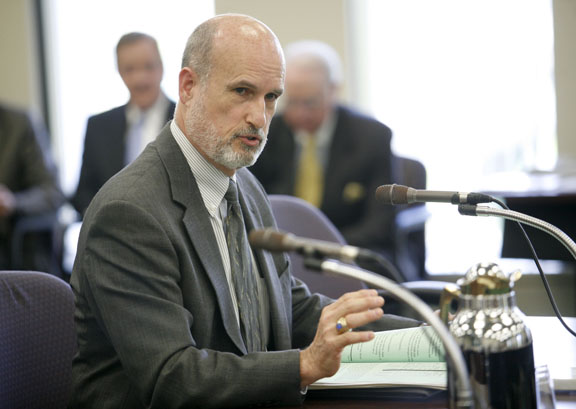
Associate Commissioner Larry Stinson speaks to the Kentucky Board of Education during its meeting April 13, 2011 about proposed recognition and assistance for schools and districts under the new assessment and accountability system. Photo by Amy Wallot
By Matthew Tungate
matthew.tungate@education.ky.gov
State end-of-course assessments for high school students will count at least 20 percent of a student’s overall course grade or school districts will have to explain why not as part of the state’s new assessment and accountability system that starts next school year.
The Kentucky Board of Education approved the measure at its April meeting as one of the final decisions about how student data will be used to evaluate schools and districts – the Next-Generation Learners component of the accountability model. Schools and districts will be accountable for five areas: student achievement; closing achievement gaps; showing growth/progress; college and career readiness (middle and high schools); and graduation rates (high schools).
Commissioner Terry Holliday told board members that Kentucky is the only southern state that doesn’t use end-of-course tests. Starting next year, the state will mandate end-of-course tests in English II, Algebra II, Biology and U.S. History. Other subjects will be added in future years. The department has chosen a vendor to provide the tests, he said, but doesn’t have a signed contract yet.
“It’s always the debate: What’s the percentage?” he said.
Associate Commissioner Ken Draut had presented the board with a proposal in which state end-of-course tests would count no less than 25 percent.
Board member Roger Marcum, a former teacher, principal and superintendent, said a lack of student accountability has caused complaints for a long time. While he believes that most schools will use and even exceed the minimum requirement, Marcum said he is concerned that such a large percentage of a student’s grade comes from tests that haven’t even been chosen yet.
Vice-Chair Dorie Combs, an education professor at Eastern Kentucky University, said she favors end-of-course tests but was concerned with the weight they would carry.
“Twenty-five percent is an awful lot for a grade,” she said. “Grades are what colleges look at. You can cut a student out of a college education by a quarter of a point of a GPA.”
Vice-Chair C.B. Akins voiced concerns that a student’s year of hard work could be undermined by being a poor test taker.
“I certainly would not want 25 percent of their overall yearly output determined with a one-day factor,” he said.
Other board members were less sympathetic.
Board member Billy Harper, a business owner, said he needs employees who can make decisions and work under pressure – and part of taking a test is working under pressure.
“It sounds cruel and hard, but it’s part of the student’s learning process,” he said.
Ultimately, it will be up to school districts to decide how much end-of-course assessments count toward a student’s grade.
Districts that choose to use end-of-course results as less than 20 percent of a student’s grade will have to justify their decision in a report to the commissioner of education by Dec. 31 of each year. Holliday said that explanation would go on school and district report cards to inform the public.
Every district with high schools will have the same conversation among its board of education members that the state board was having, Holliday said.
“You’re not making the final decision today,” he said. “Local boards will make the final decision.”
Assistance and recognition to get overhaul
Associate Commissioner Larry Stinson was prepared to discuss an assistance and recognition plan for Next-Generation Learners — but board members reversed course and sent him in a new direction.
The proposed accountability model incorporates not only student testing (Next-Generation Learners) but all aspects of school and district work. It includes measures of principal and teacher effectiveness (Next-Generation Professionals) and includes a working conditions survey and Program Reviews (Next-Generation Support Systems, which the board voted to rename Next-Generation Instructional Programs and Support).
In October, the board indicated it wanted three separate scores – one for each component of the accountability model and each with its own assistance and recognition plan.
Board members threw into question what will be done with scores in each of the three accountability areas during the April meeting, however.
With the primary accountability focus on Next-Generation Learners, Combs said she was worried about not including Program Reviews in the same category as student data.
“I’m concerned that with what we have done, they don’t really count,” she said.
Holliday reminded the board that each of the three accountability areas would be reported to schools and the public as separate numbers and asked if the board wanted one aggregate number to report for each school in addition to the three separate scores.
Several board members liked that idea. Akins, for one, was concerned that schools could receive recognition in one of the three accountability areas without doing well in all three.
“I don’t want a parent to look at a distinguished flag and not realize there is a deficiency in one of these categories,” he said.
Other board members were concerned that having one overall number would allow schools to mask deficiencies.
Harper said he hoped the board would stick with assistance and recognition for each of the three categories.
“Whatever gets measured is what gets done,” he said. “I’m afraid if you have a single score, then everything else gets lost.”
Combs said she would like to have both: individual category scores and a composite score. She compared it to making a recipe with four ingredients: shrimp, vegetables, spices and rice.
“For my dish to be very good, every ingredient has to be very good,” Combs said. “If I put in a bad vegetable, my dish isn’t going to taste good no matter how good my shrimp is.”
Stinson said he would bring the board a new regulation to review in June that provides an overall aggregate score and reports each of the three areas: Next-Generation Learners, Next-Generation Professionals and Next-Generation Instructional Programs and Support.
Program Review, working conditions survey model proposed
The board still must decide how Program Reviews and the working conditions survey will weigh in the overall accountability model.
Program Reviews have been piloted for three areas: arts and humanities, practical living and career studies, and writing. Rather than testing students to see what they have learned, a school gathers evidence about how it integrates the subjects across its curricula and whether the school provides students with high-quality learning opportunities. The school then uses that information to improve its programs.
Under a proposal brought to the board by Associate Commissioner Felicia Cumings Smith, schools would receive up to 100 points for each of the three Program Reviews. Each score would be multiplied by 30 percent, meaning Program Reviews would make up 90 percent of a school’s score under the Next-Generation Instructional Programs and Supports component. The remaining 10 percent would come from the school’s participation rate on the working conditions survey, the Teaching, Empowering, Leading and Learning (TELL) survey, which was taken for the first time this spring.
The board expressed an interest in removing the survey participation rate from the Next-Generation Instructional Programs and Supports component. It will discuss that and the overall proposal at its June meeting.
In other business, the board:
- heard information about the expansion of the AdvanceKentucky program
- heard recommendations from the Governor’s Transforming Education in Kentucky Task Force
- voted to approve a resolution supporting the Commonwealth Commitment to College and Career Readiness Pledge
- approved the appointment of Dana Guyer of Louisville as an at-large member of the Kentucky High School Athletics Board of Control
- approved the selection of EdisonLearning and Mosaica Turnaround Partners as external management organizations that can be used for assistance to low-performing schools
The next regular meeting of the Kentucky Board of Education is scheduled for June 8 in Frankfort. The board will hold a work session at 1 p.m. June 7 in Frankfort.



Leave A Comment